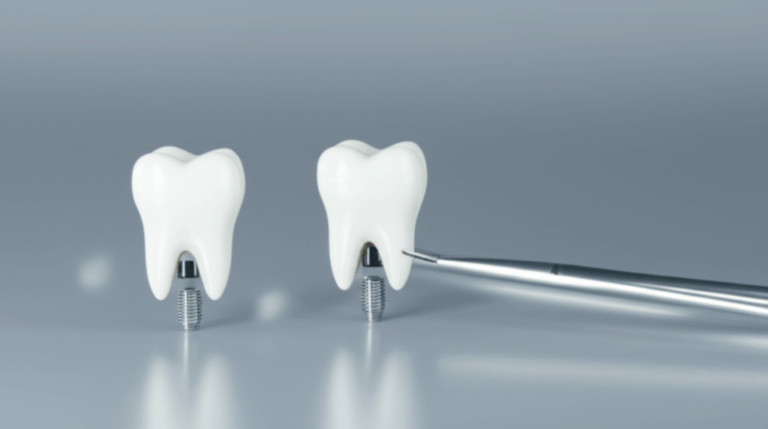
What Are Non-Surgical Dental Implants? A Simple Guide to Modern, Gentle Tooth Replacement
If you’re reading this, maybe you get uncomfortable just thinking about dental surgery—or maybe you’ve heard people talk about “non-surgical dental implants” and wonder if it could be the easier, kinder fix for your smile. Maybe you’ve put off fixing a missing tooth because you imagine scalpels, stitches, and missing work. If so, you’re definitely not the only one.
Let’s be real: dentists today care about your comfort, speed, and making sure you leave happy, not sore. That’s why non-surgical dental implants are getting more popular. They’re a big step forward if you want a strong, lasting tooth without the horror movie scenes of traditional surgery.
But what are non-surgical dental implants? Are they really “no surgery” at all? Are they safe? Who can get them? And could this be what you’ve been waiting for?
Let’s go through it together—no heavy technical talk, just clear, honest answers you can actually use.
In This Article
- Introduction: Rethinking Dental Implants
- Understanding Non-Surgical Implant Techniques
- Key Benefits of Non-Surgical Dental Implants
- Are You a Candidate? Eligibility and Considerations
- The Non-Surgical Implant Procedure: What to Expect
- Cost of Non-Surgical Dental Implants
- Potential Risks and Complications
- Non-Surgical Implants vs. Traditional Implants: A Side-by-Side Comparison
- Frequently Asked Questions
- Conclusion: The Future of Dental Implantology
Introduction: Rethinking Dental Implants
Most people, when they hear “dental implant,” picture scalpels, stitches, swelling, and a long, sore recovery. Not exactly inviting!
But what if you could skip the cut, skip the stitches, and be well on your way to a strong tooth—sometimes even in just a day?
That’s now possible because of “non-surgical,” or “flapless,” dental implants—high-tech tools for gentle dental care.
So, what does “non-surgical” really mean here?
Let’s be straight: every dental implant still needs to go into the jawbone, so there is always a procedure. But “non-surgical” means your dentist does it with the least fuss—like repairing something in your home without tearing up the whole place first.
Instead of cutting your gum open to see the bone, the dentist makes a tiny circle-shaped opening (with a tool) guided by digital scans and special planning. You can forget the drama of old-school surgery—and get a much gentler recovery.
Understanding Non-Surgical Implant Techniques
Let’s look “behind the scenes” and see what makes these gentle dental fixes work. The trick? A mix of digital planning, high-tech pictures (scans), and a dentist who knows their stuff.
Flapless Implant Placement (The Main Idea)
Think of it like this: you want to hang a picture. You could cut a large hole in the wall… but isn’t it better to measure, mark the right spot, and drill a tiny hole exactly where you need it?
That’s the difference between the old way and flapless (non-surgical) implants.
How it works:
- Your dentist takes a 3D image of your jaw (CBCT scan).
- Planning software pinpoints the best place for your implant, watching out for nerves and how your teeth fit together.
- A custom-made “guide”—like a plastic template—fits over your teeth. It marks the right place and angle for the implant.
- Instead of peeling your gum back, your dentist makes a little punch hole right over the spot.
- The implant (usually titanium or zirconia) goes in through this small hole. No big wounds or stitches needed.
No guessing. No big cuts. Just careful, simple work.
Immediate Load Implants (Sometimes Used With Non-Surgical Methods)
Some people, if their bone is healthy and the implant is tight, get a temporary tooth or bridge right away—even the same day!
This is called an “immediate load implant.” Imagine leaving your appointment with your new tooth already in place, instead of waiting months.
But this isn’t for everyone. Your bone has to be right, and your dentist will let you know.
Mini Dental Implants (MDIs)
Picture fixing a shaky table with a small screw, not a thick bolt.
Mini dental implants are thinner. They’re good for holding dentures steady or for jawbones that are thin or have shrunk over time.
Mini implants often use the non-surgical (flapless) method too. They can be a quicker, easier fix for some folks—and may cost less.
Basal Implants (A Special Option)
This is a less common but sometimes useful solution. Basal implants lock into the hardest part of your jaw. If you’ve lost a lot of bone and don’t want extra bone surgery, this could be an answer.
Sometimes you can chew with them almost right away. Your dentist can tell you if it’s a good fit for your situation.
Key Benefits of Non-Surgical Dental Implants
What makes non-surgical implants so appealing? Here’s why more people are choosing them.
Less Surgery
- No big cuts or peeling back your gums.
- Less swelling, less bleeding, and much less pain.
- Fewer weird days when you don’t want to see anyone.
Faster Healing
- Most people feel fine in just a couple days.
- You get right back to your normal life sooner.
- Many need just over-the-counter pain pills, if any.
Shorter Appointments
- Most of these implants are placed in 15–30 minutes.
- You spend less time in the dental chair and more time on what you love.
Easier Recovery
- That area in your mouth is less sore. It’s like a paper cut, not a deep scrape.
- Prescription pain medicine is hardly ever needed.
Keeps Gums Healthy
- No large cuts means your gums look more natural.
- It keeps your natural smile shape—very important for your front teeth.
Might Not Need Bone Grafts
- Because planning is so exact, you may not need extra surgery like bone building or sinus lifts (which are pretty common with the old-school implant method).
Super Accurate Placement
- Using computer guides, your implant goes exactly where it should.
- This cuts down on risk and means the result will last a long time.
Are You a Candidate? Who Should Get Non-Surgical Dental Implants
Wondering if you’re the right kind of person for non-surgical dental implants? Here’s what you need for a good chance.
Who’s a Good Fit
- Pretty good health: Like any surgery, if you have serious health problems (like out-of-control diabetes) or take certain meds, that can be a barrier. Your dentist will want you in fair shape first.
- Enough bone in your jaw: Even with this easy method, you still have to have enough good bone for the implant to hold on.
- Healthy gums: No infections or bad gum disease. Clean, healthy gums help implants stick around.
- Listening to care instructions: You must be willing to keep your teeth clean.
Why 3D Scans Matter
- Everyone who wants this needs a 3D x-ray, or CBCT scan, to see what’s going on beneath the gums.
- Dentists use these scans to plot nerves, sinuses, bone shape—so it’s safe and works well.
When Non-Surgical Implants Might Not Be the Right Choice
- If you have severe bone loss (not enough bone even for a tiny implant).
- If your jaw’s shape means it’s hard to reach the good spot (like a nerve or sinus is in the way).
- If you have gum disease or an infection.
- If you smoke a lot or really grind your teeth, healing can be worse.
- If you take certain medicines (especially those that affect bone).
If these apply, your dentist might suggest something else—or get you ready with extra steps.
The Non-Surgical Implant Procedure: What to Expect
Thinking about going ahead? Here’s exactly what happens when you get non-surgical dental implants.
Step 1: First Visit and Planning
- Dentist checks your mouth, talks about what you want, and takes pictures of your teeth with a scanner.
- You get a 3D scan (CBCT), which is like a map of your jaw.
- Planning software puts your implant in the perfect spot—a virtual “test run.”
- They make a special guide just for you—printed or milled to fit.
Step 2: Getting the Implant Placed
- You’ll get numbing stuff so you feel pressure, but not pain.
- If you’re really scared, you might be able to get a relaxing medicine.
- The dentist snaps on the guide and makes a tiny hole through your gum (just a few millimeters wide).
- They put the implant in the planned spot.
- If your bone is strong and the fit is right, you could have a temporary tooth put on right away.
Step 3: Healing and Getting Your Real Tooth
- Most people heal fast and just need simple things like saltwater rinses and eating soft foods for a bit.
- The bone “takes hold” of the implant (“osseointegration”) over several weeks or months.
- Then you come back to get your final tooth, bridge, or denture.
- That’s it—a new tooth (or teeth) that look and work like normal.
Cost of Non-Surgical Dental Implants
Money matters! So what does all this cost?
What Affects Price?
- How many implants you need: More implants, higher cost.
- Material: Most are titanium or zirconia.
- Tech used: 3D scans, digital planning, and special guides make things more exact, but come with extra charges.
- Where and who: Is your dentist a top expert in a big city, or a regular dentist in a small town? This all changes the price, too.
Comparing to Traditional Implants
Sometimes, non-surgical and traditional approaches cost about the same; sometimes guided (flapless) implants cost a bit more because of the high-tech planning. On the other hand, you might save on not needing extra surgeries.
Insurance and Payment
- Some dental insurance covers implants, some does not. Always check!
- Most offices have payment plans or offer financing.
- Get a written breakdown and ask about guarantees or follow-up care.
Potential Risks and Complications
No treatment is 100% safe—not even a “non-surgical” implant. Here’s the truth:
Lower (But Not Zero) Risks
- Infection: Still possible when working on your gums, but less risk because the spot is small.
- Hitting a nerve: 3D imaging and guides make this much less likely than in the old way.
- Implant fails: Rare, but happens if the bone isn’t great, it’s not put in right, or you smoke.
- Gum issues after: Just like gum disease, it can happen around implants if you don’t keep them clean.
Why a Good Dentist Matters
Since everything comes down to careful planning and guided tools, it’s super important to pick a dentist who is trained in this new way.
Non-Surgical Implants vs. Traditional Implants: A Quick Chart
Here’s a comparison to keep it simple.
| Feature | Non-Surgical Dental Implants | Traditional Dental Implants |
|---|---|---|
| How it’s done | Small punch hole, no cutting/sutures | Cut gum open, stitches needed |
| Healing | Quicker, little swelling, less down time | Takes longer, more swelling, off work |
| Surgery level | Much less, saves healthy tissue | More, moves/guts tissue more |
| Accuracy | Very high (computer planned) | Mostly uses dentist’s eye/feel |
| Bone Grafts | Less likely needed | Used more often |
| Time in chair | Shorter | Longer |
| Fear factor | Less (less scary surgery) | More (bigger surgery) |
Frequently Asked Questions (FAQs)
How long do non-surgical dental implants last?
With good care, they last as long as regular implants—10, 20 years, sometimes for life.
Is the procedure really pain-free?
You’ll feel pressure and maybe a little discomfort, but most just need regular pain pills. There’s much less swelling than with old-fashioned surgery.
Can everyone get non-surgical dental implants?
Not always, but a lot of people can. Mainly you need healthy bone and no big gum problems. 3D scans help the dentist know for sure.
What’s recovery like?
Most people are just a bit sore for a day or two. Way easier than open surgery. Most go back to work or normal eating fast.
How do I find the right dentist for this?
Look for someone who does lots of digital, guided implants. Ask how many they’ve done, look at photos, and read reviews.
A Closer Look at Facts, Real Stories, and Results
If you like numbers, check this out:
- Success rate: Studies say non-surgical implant success is 97–99%—just as good, or better, than the normal approach.
- Happy patients: Over 95% are pleased with how their tooth looks and feels after.
- Healing: Most feel back to normal in just 1–3 days (versus a week or more for old-style).
- Placing the implant: Computer guides put them right where they should go—usually within 1 millimeter of perfect. That’s important for safety and a strong, lasting tooth.
Real people say it’s less painful, quicker recovery, and gives them more confidence living life with their complete smile again.
Real-Life Story: Mary’s Experience
Here’s how it looked for one person (name changed):
Mary, 54, waited a long time before fixing her missing molar because “gum surgery” scared her. Her dentist showed her non-surgical, computer-guided implants. After a fast scan, a custom guide, and less than 30 minutes in the chair, her implant was done.
She went back to work the next morning, needing only ibuprofen for a little soreness. Mary says, “It felt more like a filling than an operation. I really should’ve done it earlier.”
That’s what non-surgical implants offer—less fear, more living.
Ready for Your Next Step? Is a Non-Surgical Implant Right for You?
Key points:
- Non-surgical dental implants are a tough, solid fix for missing teeth—without the tough surgery.
- You might bounce back in a few days, with hardly any pain.
- New scanning and computer tools make it safer, quicker, and gentler.
- They are great for anyone scared of surgery, who wants little downtime, or the very latest options.
Who should think about it?
- Anyone missing a tooth and in decent health;
- Folks who hate the idea of a big surgery and slow healing;
- People who want a quick, exact, high-tech result.
What should you do now?
- Schedule a visit with a dentist or implant expert who uses 3D digital planning and guided implant work.
- Ask all your questions—don’t be shy about saying you want the gentle, flapless choice if you can.
- Take care of your teeth and gums every day to give your new (and old) teeth the best life.
Bonus tip: For more on how digital tech changes the whole process, from custom crowns to guides, explore more about digital dental labs here.
Quick Recap
- Non-surgical (flapless) dental implants use smart scans and digital tools for gentle, small-impact placement.
- You avoid the long healing, swelling, and big scars of classic surgery.
- Most people need healthy gums and enough bone—the dentist checks this with 3D x-rays.
- Fast, careful, simple recovery; most are back to normal in a couple days.
- Risks are low, but not zero—it’s important to pick a dentist who’s trained in guided implant work.
- Studies show these work as well (or better) than standard implants, and satisfaction is high.
- Want to know about more ways to replace teeth or learn about good mouth care? Check teeth health basics for broader information.
Final Thoughts: The Future of Dental Implants
The future for fixing missing teeth is here, and it’s faster, softer, and more reliable than before.
Non-surgical (flapless) implants are a huge step toward dental care focused on making life easier for real people. You may get your smile back—more quickly and with less worry, start to finish.
Still deciding? Take that first step: talk to a dentist who offers the latest in digital planning and flapless (no-surgery) techniques.
A full, strong smile—and maybe a happier you—could be just one gentle, high-tech visit away.
To read more about good mouth care habits or what makes those strong, natural-feeling dental materials, try dental care too. A healthy, happy smile starts today!








